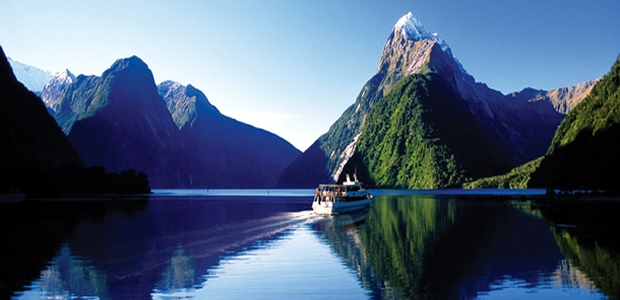Carved by a glacier 20,000 years ago, New Zealand’s Milford Sound teems with unique varieties of wildlife. Here, fresh water and sea water meet uneasily to create an environment that is part lake, part ocean. The majestic beauty of Milford Sound’s soaring cliffs and deep blue glittering waters, edged by dense forests, prompted the English writer Rudyard Kipling to declare it the ‘eighth wonder of the world’.
It is one of the wettest places on Earth: rain falls on two out of three days, giving an exceptionally high annual rainfall of 255in (650cm). This precipitation swells cascades of water which tumble 1000ft (300m) or more to the inlet below. Looming above the entrance to the Sound is Mitre Peak, an awesome natural sentinel that rises to a height of 5560ft (1695m).
The crest of Mitre Peak, the highest point of the mountains surrounding the sound, is often shrouded in cloud and mist. Torrential rain pouring down the sides of the mountains replenishes the layer of fresh water on the surface of Milford Sound, sustaining a unique marine environment.

Situated 160 miles (260km) north-west of Dunedin, on New Zealand’s South Island, Milford Sound has many of the characteristics of a typical fjord, it is a narrow inlet, 10 miles (16km) long, with steep sides and, like most fjords, is shallow at the mouth and deeper at the head. It was formed during the last ice age by a glacier, which gouged out a deep trench in the rock as it inched its way seaward. When the ice retreated some 10,000 years ago, the Tasman Sea flooded into the glacial valley.
The water in the sound lies in three layers. The surface layer has a low salt content because it is produced by fresh water flowing in from streams and waterfalls. It is less dense than the sea water in the fjord and lies on top of it, forming a layer 10ft (3m) deep or more. As the surface layer drifts towards the sea, it carries with it some of the salt water from below, creating a transitional zone of brackish water. This movement creates a counter current that draws sea water into the fjord to a depth of 100ft (30m); below this the water is salty but largely immobile.
The fresh water has a profound effect on the marine life of Milford Sound, which presented the first divers to explore it with something of a puzzle. For example, the usual species of seaweed and shellfish that inhabit the tidal waters along the rest of New Zealand’s coastlines are not found in the sound because they cannot survive in waters of such low salinity. Instead, the upper layer is occupied by species such as sea lettuce, blue mussels and barnacles that can tolerate brackish water. Starfish cling to the underwater cliffs in the uppermost salty layer, where they feed on mussels. As the tide goes out and the water level falls, the starfish move down the rock to avoid the top freshwater layer, which they cannot tolerate; when the tide comes in again, they climb back up to resume feeding.
Fiordland’s high rainfall feeds spectacular cascades, such as the Bowen Falls, which thunder down the mountainsides all round Milford Sound, creating a veil-like spray on impact with the rocks below.

The run-off from the mountains flows over beds of moss and humus-rich soils, so when it reaches the fjord it is stained the colour of tea. This brown water restricts the penetration of sunlight, with the result that deep-water marine species such as sea feathers, sea squirts, black coral and lamp shells live high up among ledges and fissures of the rocky walls at depths of between 20 and 130t (6 and 40m) – much shallower than their usual habitat.
The rare black coral that usually lives in colonies at depths below 150ft (45m) Is found in Milford Sound at less than 115ft (35m) and in some places survives at a mere 20ft (6m) deep – closer to the surface than anywhere else in the world. Most of the coral colonies resemble miniature feathery bushes about 4in (10cm) or so high, but some corals, estimated to be more than 150 years old, have developed into huge treelike structures 13ft (4m) tall.

Milford Sound and its forested mountains, which are protected within the World Heritage Area of Fiordland National Park, shelter a rare and strange bird known as the takahe. This flightless creature with vivid green and blue plumage is about the size of a domestic chicken, has a large bill, and feeds solely on the leaves and seeds of snow grass. It was thought to be extinct until, in 1948, a small colony of birds was discovered on the alpine grasslands above Lake Te Anau, some 34 miles (55km) south-east of Milford Sound. Today the bird is protected and still lives in the park.

Even rarer is the kakapo, a ground dwelling, greenish parrot that resembles an owl and lives in a burrow by day. It, too, was nearing extinction before the few surviving pairs were moved to offshore islands where they are now breeding successfully.




































